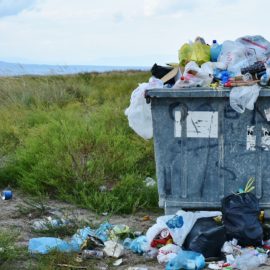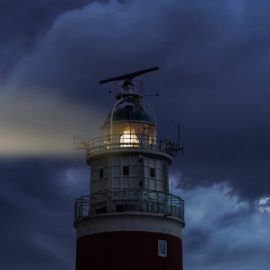
Usually the state says we need to be like Texas (not me). Now Houston says they want protection like us.
Kelly Burks-Copes braces herself against the wind and marches past the ruins of Fort San Jacinto, a strategic spot on a sandy, wave-battered point where Spain, France, the Republic of Texas, the Confederacy and the United States have all taken turns building coastal defenses to protect Galveston Bay. Now it’s Burks-Copes’ turn. The U.S. Army Corps of Engineers project manager is leading an ambitious effort to build the “Ike Dike,” a $30 billion storm protection project that’s been in the works since its namesake hurricane roared through the bay almost 14 years ago. The project will dwarf the one built around New Orleans after Hurricane Katrina and perhaps even the immense coastal barriers in the Netherlands that inspired both Gulf Coast projects. “If it’s not the largest surge barrier in the world, it’s certainly the world’s longest,” Burks-Copes said, pointing at the 2.5-mile-wide channel between the old fort site on Galveston Island and the Bolivar Peninsula. By comparison, the Lake Borgne surge barrier between New Orleans East and St. Bernard Parish, once considered the world’s largest, is 1.8 miles long. Had the New Orleans system been built today, it’d cost about 70% as much as the Houston system. “It’ll be like a 10-story building all the way across,” Burks-Copes said of the Galveston Bay surge barrier. “It’s something that you can barely imagine. But what do they say in Texas? ‘Go big or go home.’”
nola.com
Protecting 70 miles of coastline this is a big undertaking.
The project aims to harden 70 miles of coastline with artificial dunes, sea walls and vast steel gates, making the bay a veritable fortress that could be sealed when hurricanes threaten. It’s ambitious and expensive, but it still may be woefully inadequate — just like New Orleans’ system. Neither project is likely to hold up against the worst hurricanes. The New Orleans collection of levees and floodwalls is designed to withstand storm surges with a 1% chance of occurring in any given year, a so-called 100-year storm. The Ike Dike may not even meet that level of protection, the Corps admits. Climate change is increasing the likelihood that 100-year storms and floods could occur every few years, with monster 500-year storms popping up every 50 to 100 years. The Houston area has seen no fewer than three such events, including Hurricane Harvey, between 2015 and 2018. “Look, (the Ike Dike) needs to be built,” said Jim Blackburn, an environmental lawyer who teaches at Rice University in Houston. “But it needs to be built for the bigger storms to come. It will be way outdated once it’s constructed.”
Ida could have flooded the West Bank has she not veered to the west.
Hurricane Ida likely would have spilled over some levees on New Orleans’ West Bank had its path last August veered just 15 miles to the east, according to an analysis this month by the National Hurricane Center. The Corps says it needs almost $2 billion to shore up New Orleans-area levees, which are expected to sink by almost 2 feet over the next 50 years from soil subsidence and rapidly rising seas. The Corps has had a tough time finding the $2 billion for New Orleans’ levees, and an even tougher time drumming up the nearly $30 billion for the Ike Dike. Texas recently formed the Gulf Coast Protection District, a new state body that has the authority to levy taxes and issue bonds for the Ike Dike. Texas will likely be on the hook for 35% of the costs, but the rest will have to come from a federal government that hasn’t shown much enthusiasm for the project. The state’s congressional delegation supports it, but the group’s passion has been in short supply. “You had Mary Landrieu. We don’t,” said Bob Mitchell, president of the Bay Area Houston Economic Partnership, naming the former U.S. senator who championed New Orleans’ storm protection system. “After Katrina, she went and put two lines in a bill for billions of dollars and said it had to be designed and built in four years. We do need a champion. We need a Mary Landrieu.” If the project breaks ground in 2024, as scheduled, construction will likely take 19 years. “We’re looking at this as a generational project,” Burks-Copes said.

U.S. Coast Guard
There is every chance the Texas coast will be hit by a major storm as the Ike Dike is being built.
There’s a strong likelihood that a dangerous storm will strike the Houston area before the project is finished. Major hurricanes in the Gulf are expected to increase in frequency by 13% to 83% over the next 50 years, according to the Louisiana Coastal Protection and Restoration Authority. In 2008, Hurricane Ike was aiming for the city as a Category 4 storm but dropped to a Cat 2 just before swerving north to a less populated stretch of Galveston Bay. Ike was still plenty bad, killing 77 people in Texas and causing more than $27 billion in damage. But had it stayed on course for Houston, as a future storm might do, the outcome would have been much worse, said Hanadi Rifai, a hurricane researcher at the University of Houston. Of particular concern, she said, is the Houston Ship Channel, a 52-mile-long waterway connecting the metro area with the Gulf that is crowded with the continent’s largest collection of petrochemical plants and oil refineries. “There would be catastrophic damage,” she said of an Ike-strength hurricane striking Houston. “It would produce a surge about 25 feet high and send it into the ship channel, where almost every facility would be affected.” The narrow channel would concentrate the surge, intensifying its power much like a thumb pressed over the opening of a garden hose. In its path: about 900 industrial facilities and more than 4,300 aboveground storage tanks, many containing flammable and toxic materials used to make a variety of products, including plastic, solvents and gasoline.
The hurricane effects would be magnified by the damage to the oil and gas facilities up the channel.
A hurricane is dangerous enough, but one that bashes through chemical tanks and cleaves oil pipelines would put the disaster on another level. It could produce a toxic stew of oil, chemicals, and industrial debris that would flood Houston’s urban bayous, spill into neighborhoods, and foul the bay. About 6 million people live in the metro area. “It really is a potential Chernobyl,” said John Pardue, a hazardous substances researcher at LSU. “The Houston area has such a large number of tanks and the potential for so many chemical releases all at once.” Michel Bechtel, president of the Gulf Coast Protection District and the mayor of Morgan’s Point, a small town at the mouth of the ship channel, knows first-hand the risks storage tanks pose. When Katrina flooded Chalmette, Bechtel’s hometown, it ruptured an immense tank at a Murphy Oil refinery, releasing more than a million gallons of thick black crude. The oil and floodwater inundated nearly 2,000 homes, including Bechtel’s parents’ house and a cottage Bechtel, then a newlywed oil engineer, had just built to start his family. “It was just a total wipeout for everybody,” he said, showing photos of Chalmette homes with thick, black stains at the high-water line. Morgan’s Point sits across the channel from a dense cluster of similar tanks. “There’s lots of stuff in those tanks that you don’t want floating around or washing back into the bay,” he said.
Katrina was the catalyst for the protection we now have.
Katrina’s destruction spurred storm protection spending like never before. Congress made the Corps’ full request – $14.6 billion – available at the beginning of the project, a dramatic change in approach from the previous 40 years, which saw individual levees and floodwalls built in fits and starts. But that’s how things are still done in the Houston area. The Ike Dike is essentially a pre-disaster project done at a post-disaster scale.

Army Corps of Engineers
There will be a series of gates along the length of the dike.
From where Burks-Copes stood at the old fort site, the Corps plans to build a series of gates spanning from the northeast part of Galveston Island to the Bolivar Peninsula, crossing the 2.5-mile channel connecting the Galveston Bay and the Gulf of Mexico. The span will include 15 vertical lift gates and four swinging gates, the largest of which would be 650 feet long. The swinging gates would allow ships to pass. Several culverts and small gates in the shallow areas would permit fish and shrimp to swim in and out. The project would bulk up the “ring barrier system,” stretching around the backside of Galveston Island. Because this closed system of floodwalls, gates and levees could trap water as well as keep it out, the Corps plans to install six new pump stations. The decision to build a sandy beach and 12- to 14-foot-tall dunes to protect about 43 miles of the coast has proven controversial. Bechtel, the Morgan’s Point mayor, and other Galveston Bay leaders want something sturdier than sand. “That’s just going to wash away,” Bechtel said. “Storms that hit Louisiana — 200 miles away — wiped out natural beaches all the way over on Galveston Island. We want a good, consistent barrier all the way across.”

Army Corps of Engineers
Beach access and views of the beach are draws for the visitors.
But Burks-Copes said walls or anything taller than 14 feet would block views and access to the bay. “Beach access – for residents and tourists – it’s a way of life here,” she said. The bulked-up beach and dunes are also a “nature-based solution” that will boost habitat for several species, including endangered sea turtles, more of which nest on Texas beaches than any other part of the U.S. Gulf coast. “We have to be careful how we restore the beach,” Burks-Copes said. “For sea turtles, the type, color, and temperature of the sand is what determine the sex of their young.” She concedes the sand won’t stand up to repeated surges, but she said it can be rebuilt between storms. “The sand is sacrificial, but we can replace it fast,” she said. The system won’t stop everything, Burks-Copes admits. Strong surges could overtop the walls and dunes, and Galveston will still need to evacuate during some hurricanes, she said.
There are alternatives to what is proposed.
Blackburn, the environmental lawyer, has been promoting an alternative storm protection plan that he now says can complement the Corps project. Known as the Galveston Bay Park Plan, the $6 billion proposal developed by Rice University hurricane researchers would use dredged material to construct a string of islands in the bay that would double as surge barriers and provide about 10,000 acres of recreational space. “It’d be a redundant feature to what we’re doing,” Burks-Copes said. “It can take the edge off whatever remains of a storm.” Bechtel says the Park Plan, which has far less momentum, is little more than a distraction.
Money. That is what is needed as we see here.
The Ike Dike is already clearing what could be years of regulatory hurdles and has a much better chance of becoming a reality. But its immense price tag is a looming concern. Mitchell doesn’t try to pretend he’s not jealous that New Orleans got much of its storm protection system more than a decade ago and Houston is still waiting. Houston, he said, should have been a higher priority, both for its larger population and its outsized importance to the nation’s economy. “The New Orleans’ levee system was to protect 340,000 people and Bourbon Street,” he said. “We want to protect 5.5 million people and all these products and fuel that the whole country and the world needs.” Mitchell says he knows what will speed up the process: a deadly, Katrina-size storm. “If Houston gets a hurricane that kills 2,000 people like Katrina did, we will get a check the next week, and we will build our protection system in three and a half years,” he said. “In the second scenario — the one without a hurricane — it takes 20 years and every year we’re asking the feds for money.”
Death and destruction are not really desired but…
Burks-Copes hopes death and destruction aren’t the only motivators of political leaders. Despite the project’s high costs, she stresses that the Ike Dike would reduce structural damage by an estimated $2.3 billion annually. “For every dollar spent, we save two in what we’re protecting,” she said. “When I say it pays for itself after one storm, I’m not kidding.” But that one storm is yesterday’s storm, Blackburn said. Tomorrow’s storm isn’t going to act like Ike or the relatively weak storms the Ike Dike is built to withstand. “They’re building for a Category 1 or 2 storm, but it’s the 3s, 4s and 5s that we should be building for as our planet warms,” he said. “We have not caught up with the reality of climate change. Until we wrap our heads around what’s to come, we’re going to have to deal with more severe storms that cause a lot more industrial spills and kill a lot more people.”
Looked at another way, it means that we will have competition between us and them for money.



